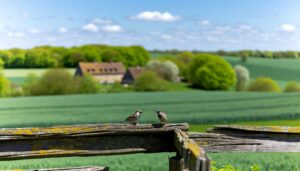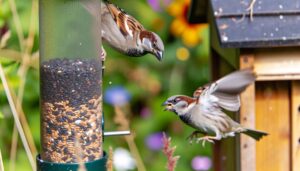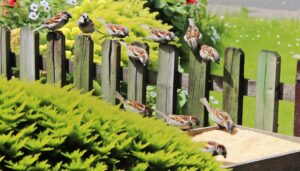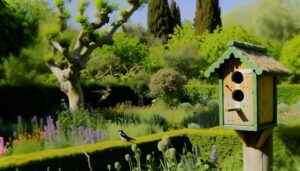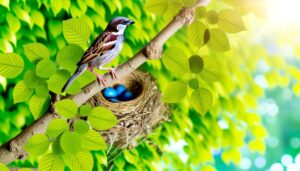3 Key Differences Between Eurasian Tree Sparrow Vs House Sparrow
The Eurasian Tree Sparrow (Passer montanus) and House Sparrow (Passer domesticus) present distinct characteristics. The Eurasian Tree Sparrow features a chestnut crown and black cheek spots, whereas the House Sparrow shows a gray crown and a prominent black bib in males.
Geographically, Eurasian Tree Sparrows inhabit rural and suburban areas in Europe and Asia, while House Sparrows, originally from Europe and North Africa, thrive globally, especially in urban settings. Their diets reflect their habitats; Tree Sparrows prefer seeds and insects, whereas House Sparrows consume a wider variety.
Both species exhibit unique nesting behaviors and social structures. For a deeper understanding of their ecological roles and conservation statuses, continue exploring.
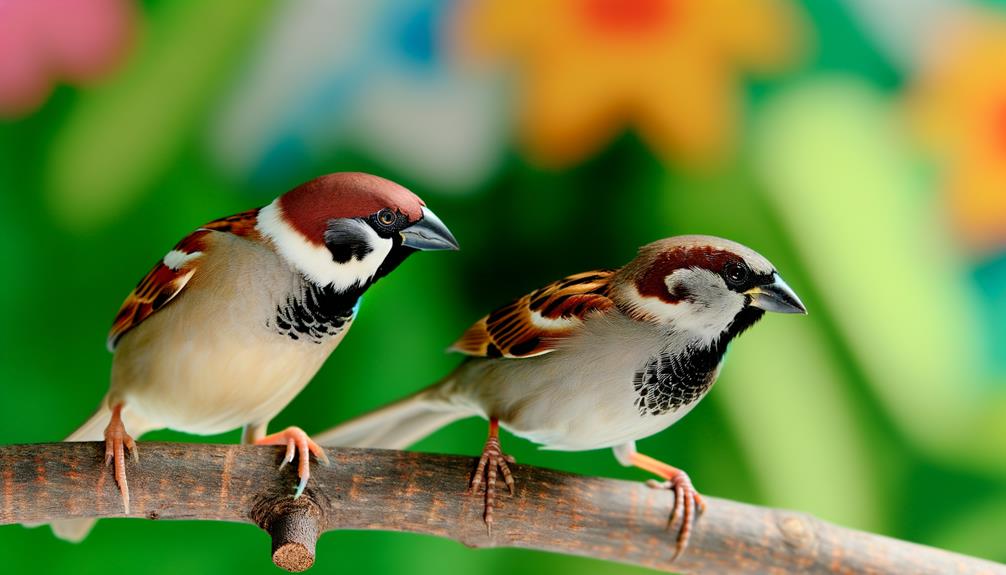
Key Takeaways
- Physical Appearance: Eurasian Tree Sparrow has a chestnut crown and black cheek spots, while House Sparrow has a gray crown and black bib.
- Geographic Distribution: House Sparrows are widespread globally, whereas Eurasian Tree Sparrows are confined to Europe and Asia.
- Habitat Preferences: House Sparrows thrive in urban environments; Eurasian Tree Sparrows prefer rural and suburban areas.
- Feeding Habits: House Sparrows adapt to urban food sources, while Eurasian Tree Sparrows primarily consume insects and seeds in rural settings.
- Social Structure: Tree Sparrows form loose flocks for protection, whereas House Sparrows exhibit rigid social hierarchies.
Physical Appearance
The Eurasian Tree Sparrow (Passer montanus) and the House Sparrow (Passer domesticus) exhibit distinct differences in their physical appearance, most prominently in their plumage coloration and facial markings.
The Eurasian Tree Sparrow is characterized by a rich chestnut crown and nape, black cheek spots, and a white collar, distinguishing it from its counterpart. In contrast, the House Sparrow displays a gray crown, black bib, and a more uniformly brown back.
Additionally, the male House Sparrow has a more pronounced black throat patch and a white stripe over the eye, absent in the Eurasian Tree Sparrow.
Females of both species are more subdued in coloration, but the Eurasian Tree Sparrow retains its distinctive white cheek spots, which are not present in female House Sparrows.
Geographic Distribution
Beyond their distinct physical appearances, the Eurasian Tree Sparrow and the House Sparrow also exhibit notable differences in their geographic distribution.
The Eurasian Tree Sparrow (Passer montanus) is primarily found across Europe and Asia, extending from Western Europe to Eastern Asia. Its range includes temperate regions, where it thrives in rural and suburban areas.
Conversely, the House Sparrow (Passer domesticus) displays a more cosmopolitan distribution, originally native to Europe, North Africa, and parts of Asia, but now widespread across the Americas, Australia, and New Zealand due to human introduction. The House Sparrow's adaptability to urban environments has facilitated its global spread, whereas the Eurasian Tree Sparrow remains more regionally confined, reflecting differing ecological niches and dispersal mechanisms.
Habitat Preferences
Exhibiting distinct habitat preferences, the Eurasian Tree Sparrow mainly inhabits rural and suburban areas, favoring open woodlands and agricultural landscapes, while the House Sparrow shows a marked preference for urban environments, thriving in cities and towns.
The Eurasian Tree Sparrow's affinity for areas with abundant vegetation and agricultural activity allows it to exploit a variety of nesting sites, such as tree cavities and hedgerows. Conversely, the House Sparrow's adaptability to densely populated human settlements is evident in its choice of nesting sites, which include buildings, eaves, and other man-made structures.
This divergence in habitat selection highlights their differing ecological niches, with the Eurasian Tree Sparrow occupying more natural settings and the House Sparrow being highly synanthropic, coexisting closely with human activity.
Feeding Habits
The feeding habits of the Eurasian Tree Sparrow (Passer montanus) and the House Sparrow (Passer domesticus) exhibit notable differences, particularly in their diet preferences, urban versus rural feeding behaviors, and seasonal food choices.
While both species primarily consume seeds and grains, the House Sparrow shows a greater adaptability to urban environments, often feeding on human food waste. Conversely, the Eurasian Tree Sparrow tends to rely more on natural food sources such as insects and seeds found in rural settings, with variations in diet reflecting seasonal availability.
Diet Preferences Comparison
Both the Eurasian Tree Sparrow (Passer montanus) and the House Sparrow (Passer domesticus) demonstrate distinct dietary preferences influenced by their respective habitats and ecological niches.
Eurasian Tree Sparrows primarily consume seeds from grasses and cereals, supplemented by small invertebrates during the breeding season. This diet reflects their preference for semi-open landscapes and farmlands.
House Sparrows, on the other hand, exhibit a more generalized diet. They feed on a variety of seeds, grains, and human-provided food sources, including discarded bread and food remnants. Their dietary flexibility allows them to thrive in diverse environments, from urban to agricultural settings.
Both species' diets underscore their adaptive strategies, facilitating their survival across varying ecological contexts.
Urban Vs. Rural Feeding
Urban and rural habitats present distinct feeding opportunities and challenges for the Eurasian Tree Sparrow and the House Sparrow, influencing their foraging behaviors and dietary adaptations.
In urban environments, House Sparrows (Passer domesticus) exploit human-provided food resources, such as breadcrumbs and waste, indicating an opportunistic feeding strategy. Conversely, Eurasian Tree Sparrows (Passer montanus) demonstrate greater reliance on natural food sources, even in urban settings, such as seeds and insects.
In rural areas, both species show increased consumption of seeds from agricultural lands, but the Eurasian Tree Sparrow is more inclined towards foraging in hedgerows and woodlands. This divergence in feeding habits underscores each species' adaptability to varying human influence and habitat structure, reflecting their evolutionary ecological niches.
Seasonal Food Choices
Adapting to seasonal variations, Eurasian Tree Sparrows and House Sparrows exhibit distinct shifts in their feeding habits to optimize nutritional intake throughout the year. During spring and summer, both species mainly consume insects and larvae, providing essential proteins necessary for breeding and rearing young.
Eurasian Tree Sparrows display a higher inclination towards aphids and caterpillars, while House Sparrows often target beetles and grasshoppers. As autumn approaches, their diets shift towards seeds and grains, with Eurasian Tree Sparrows favoring weed seeds, and House Sparrows showing a preference for agricultural grains.
In winter, both species rely heavily on available seeds and human-provided food sources, but House Sparrows demonstrate greater adaptability to urban environments, scavenging from bird feeders and waste.
Nesting Behaviors
The nesting behaviors of the Eurasian Tree Sparrow (Passer montanus) and the House Sparrow (Passer domesticus) reveal distinct preferences and strategies.
The Eurasian Tree Sparrow typically selects cavity sites in trees or buildings, whereas the House Sparrow often opts for crevices in urban structures.
Both species exhibit unique material selection processes and exhibit variability in nesting season timing, influenced by environmental conditions and geographical location.
Nesting Site Preferences
Eurasian Tree Sparrows often display a distinct preference for nesting in tree cavities and man-made structures, whereas House Sparrows mostly favor urban environments and readily exploit available crevices in buildings and other human-made constructions.
The Eurasian Tree Sparrow's inclination for tree cavities is a notable adaptation, allowing them to thrive in both rural and suburban landscapes. They commonly utilize abandoned woodpecker holes or natural hollows.
In contrast, House Sparrows demonstrate remarkable adaptability to urban settings, often nesting behind signage, in ventilation systems, and under roof eaves. This preference for anthropogenic structures underscores their symbiotic relationship with human-modified habitats.
Material Selection Process
House Sparrows and Eurasian Tree Sparrows exhibit distinct material selection behaviors during nest construction, reflecting their unique ecological niches and adaptive strategies. House Sparrows typically favor urban environments and use a variety of man-made materials for their nests, such as string, paper, and plastic.
Conversely, Eurasian Tree Sparrows, which prefer rural or semi-natural habitats, mainly utilize natural materials like grass, twigs, and feathers. This divergence underscores their adaptability to different environments.
Key observations include:
- House Sparrows: Mainly use synthetic materials.
- Eurasian Tree Sparrows: Rely heavily on organic, natural substances.
- Urban Adaptation: House Sparrows showcase greater flexibility in material choice.
- Rural Preference: Eurasian Tree Sparrows maintain traditional nesting material usage.
Nesting Season Timing
Nesting season timing for both Tree Sparrows and House Sparrows exhibits notable differences, reflecting their respective ecological adaptations and breeding strategies.
The Eurasian Tree Sparrow (Passer montanus) typically initiates its nesting season in early April, extending through July. This period aligns with increased availability of insect prey, essential for chick development.
In contrast, the House Sparrow (Passer domesticus) demonstrates greater flexibility, often beginning as early as March and continuing until August. This extended period allows multiple broods, enhancing reproductive success.
House Sparrows exploit urban environments, where food resources are more predictable year-round, enabling earlier and prolonged breeding. These temporal nesting differences underscore the distinct evolutionary pressures and habitat preferences shaping their reproductive behaviors.
Social Structure
The social structure of both the Eurasian Tree Sparrow and the House Sparrow exhibits distinct hierarchical patterns and communal behaviors, shaped by their respective environmental adaptations and breeding strategies. Detailed observations reveal that:
- Eurasian Tree Sparrows tend to form loose, less cohesive flocks, primarily during non-breeding seasons, relying on collective vigilance for predator avoidance.
- House Sparrows display a more rigid social hierarchy within their flocks, with dominant individuals often securing better access to resources and nesting sites.
- Both species exhibit territorial aggression during the breeding season, although House Sparrows are noted for their more pronounced territorial disputes.
- Communal roosting is a common behavior in both species, which enhances warmth retention and provides greater protection against predators during colder months.
These social structures are fundamental to their survival and reproductive success.
Vocalizations
Vocal communication in both the Eurasian Tree Sparrow and the House Sparrow is characterized by a complex array of calls and songs, each serving distinct purposes such as mate attraction, territory defense, and alarm signaling.
The Eurasian Tree Sparrow (Passer montanus) emits a high-pitched 'cheep' or 'chip' call, often in rapid sequences, primarily for social cohesion within flocks.
Conversely, the House Sparrow (Passer domesticus) employs a more varied vocal repertoire, including chirps, cheeps, and a distinctive 'chirrup' used by males during courtship.
Alarm calls in both species are sharp and quick, effectively alerting conspecifics to predators.
Despite their vocal similarities, the House Sparrow's broader range of calls reflects its more diverse social interactions and ecological adaptability.
Lifespan and Mortality
The Eurasian Tree Sparrow (Passer montanus) and the House Sparrow (Passer domesticus) exhibit distinct differences in their average lifespans, with the former typically living up to 3 years in the wild while the latter can live up to 4-5 years.
Common mortality factors affecting both species include predation, disease, and habitat loss, although variations in their ecological niches may influence the prevalence of these threats.
Understanding these aspects is vital for conservation efforts and biodiversity management strategies.
Average Lifespan Comparison
Eurasian Tree Sparrows typically have a slightly shorter average lifespan compared to House Sparrows, with various ecological factors influencing their respective mortality rates. Detailed observations indicate that the average lifespan of Eurasian Tree Sparrows is generally around 3-5 years, whereas House Sparrows can live between 3-7 years.
This discrepancy can be attributed to several factors:
- Habitat Variation: Eurasian Tree Sparrows often inhabit rural areas with different survival challenges compared to the urban environments favored by House Sparrows.
- Predation Rates: Higher predation rates in rural settings may contribute to the shorter lifespan of Eurasian Tree Sparrows.
- Food Availability: Urban environments often provide more consistent food sources.
- Disease Exposure: Different exposure levels to diseases also play a role in their respective lifespans.
Common Mortality Factors
Examining common mortality factors reveals that both Eurasian Tree Sparrows and House Sparrows face threats such as predation, disease, and environmental stressors, which greatly impact their lifespan and overall survival rates. Predation from avian and terrestrial predators is a significant cause of mortality. Diseases, particularly avian pox and salmonellosis, also contribute to population declines. Environmental stressors, including habitat destruction and food scarcity, exacerbate mortality rates. Both species exhibit similar vulnerabilities, though local environmental conditions may influence specific threats more significantly.
| Factor | Eurasian Tree Sparrow | House Sparrow |
|---|---|---|
| Predation | High | High |
| Disease | Moderate | Moderate |
| Environmental Stress | High in urban areas | High in agricultural areas |
Detailed understanding of these factors is vital for effective conservation strategies.
Role in Ecosystems
In considering the role of the Eurasian Tree Sparrow and the House Sparrow within their respective ecosystems, both species serve as important agents in seed dispersal and insect population control. Their ecological contributions can be summarized through several key activities:
- Seed Dispersal: Both sparrows consume a variety of seeds, aiding in plant propagation and genetic diversity within their habitats.
- Insect Control: By preying on numerous insects, they help maintain a balanced ecosystem and reduce pest populations.
- Nesting Sites: Their nesting behaviors create microhabitats for other small organisms, promoting biodiversity.
- Food Source: Both sparrows serve as prey for higher trophic levels, supporting the food web dynamics.
These roles underscore their critical functions in maintaining ecological balance.
Conservation Status
How do the conservation statuses of the Eurasian Tree Sparrow (Passer montanus) and the House Sparrow (Passer domesticus) compare in the context of global population trends and regional threats?
The Eurasian Tree Sparrow is listed as Least Concern by the IUCN, though it faces regional declines due to habitat loss and agricultural intensification.
Conversely, the House Sparrow, also classified as Least Concern, has experienced significant population decreases in urban areas across Europe and North America, attributed to factors such as pollution, food scarcity, and nesting site reduction.
Both species, while not currently endangered, exhibit regional vulnerabilities requiring targeted conservation strategies to mitigate specific threats and support population stability.
Conclusion
The comparative analysis of the Eurasian Tree Sparrow and the House Sparrow reveals distinct differences in physical appearance, geographic distribution, and ecological roles, akin to examining the nuanced contrasts between two literary archetypes.
While the Eurasian Tree Sparrow prefers wooded and rural habitats, the House Sparrow thrives in urban settings. Both species exhibit unique vocalizations and nesting behaviors, contributing differently to their ecosystems.
Understanding these distinctions is essential for effective conservation strategies, given their varying responses to environmental pressures.

